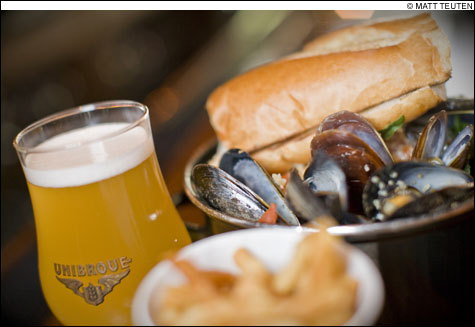
BEER NECESSITIES: Moules frites are just one example of the fine cuisine á la biére.
|
| The Publick House | 617.277.2880 | 1648 Beacon Street, Brookline | Open Mon–Fri, 5 pm–2 Am; and Sat & Sun, 4 pm–2 am | DI, MC, VI | Full bar | No valet parking | Access up slight threshold bump to some tables |
After hearing that the owners of the Publick House are opening a large barbecue palace a block up away from their current venture in Brookline, I went to check it out. Work on that project is continuing. Meanwhile, the original bar-restaurant is going great, with its unusual menu of Belgian specialties focused on French fries (as are most Belgians) and cuisine à la bière. The true focus here is the far frontiers of craft brewing, especially the many styles of Belgian ales. Those are served promptly in the manufacturer’s glassware, while food can be slow. The Belgian dishes we had were awkwardly flavored; most patrons were enjoying either the excellent frites or more typical pub food, especially in the key of fried.To start, then, with the draught brews (of which there are 36, along with more than 100 bottles), we tried Affligem Blond ($7), which is actually an amber Belgian ale. I think it’s supposed to be served a little warmer, but it was clean, with the wine-y and unusual flavors of the Belgian style. At seven percent alcohol, it creeps up on you. For the true blond (if somewhat cloudy) pour, I preferred Unibroue Éphémère, a “white ale” brewed with some boiled apple juice. By keeping the alcohol down to 5.5 percent, this Quebec microbrewery gets a cider aroma and flavor, warming to pear and spice.
There are really only two appetizers: Monk’s Frites ($6) and moules frites ($7/appetizer; $14/dinner). These are made with hand-cut Yukon Gold potatoes and served in a paper cone, as they would be in Belgium, with various dips. Some fries are crisp, some are not, and all have wonderful potato flavor. The smaller portion served with the mussels is served in a drinking cone. The mussels are leaner than their shells would imply, which is the norm for the season. There is a choice of five different “pots” for the mussels; we had pot Number 2, based on Affligem Blond, Asiago cheese, tomatoes, spinach, and garlic. We were licking the shells to get all the cheese, then using them for spoons to have the broth. The ale gave it a bitter finish, perhaps best with the grilled garlic bread provided.
My favorite entrée was the Belgian mixed seafood stew ($16), combining fish, scallops, shrimp, mussels, and bits of sausage in a light tomato-cream-dill broth that just wouldn’t quit. I used about four times as much of the grilled bread on this bowl. The only weakness was slightly undercooked potatoes.
Stoemp saucisse ($12) is a platter of five sausage balls surrounding a heap of potatoes mashed with leeks and flavored with sweet spice, perhaps allspice. The brown gravy had ale in it though was otherwise sub-diner quality. Stoemp also comes fried ($8). The sausages were mild and mixed with green onion, and fried until they were crusty.
Carbonade à la Flamande ($15) is classic beer cuisine, a slow stew of grilled sliced meat with onions, potatoes, celery, carrots, and lots of ale. I expected it to be bitter; instead, the gravy was sweet and sour. A green salad ($3) featured leaves of various greens in a deep bowl with a light dressing. It was rather a bargain.
There are no desserts. There are, however, sweet beers, though the menu tempts one to explore some of the wilder reaches of the brewing universe: lambic, gueuze, rye beer, eisbock, weizen-doppelbock, biere de Champagne. The lengthy and descriptive beer list explains what all of these things are. The last, for example, is a Belgian ale that’s brewed in Belgium, then shipped to the Champagne region of France to be re-fermented in Champagne bottles by the local method (freezing the necks and removing the spent yeast). This reportedly adds another layer of flavor, and certainly adds some alcohol.
To build the appetite for exotic brewskis, the main room is decorated with promotional beer material. My favorite is the poster for Scaldis Belgian Ale, which clocks in at 12 percent alcohol: “Deliciously strooth. Reassuringly smong.” After some of these unusual beers, you could look at that poster for a long time trying to figure it out.
There are also outdoor tables and a special tasting room called the Monk’s Cell. The whole space, which used to be the Tam, has some of the old woodwork that’s been turned into a semi-Gothic theme that suits the idea of monasteries, where many Belgian ales and cheeses are crafted. The lamps and a few arch decorations follow this theme, while Tuscan yellow walls and copper-color pillars and booths made from old pews do not disrupt it.
It is not, however, one of the silent orders. This place is loud. There’s background music, though only a bass player could identify the songs; it all tends to sound like the Clash. One song even had the bass line from “London Calling,” but I’m not betting the farm, or even the spare storage cask, on this identification.
Robert Nadeaucan be reached atRobtNadeau@aol.com.